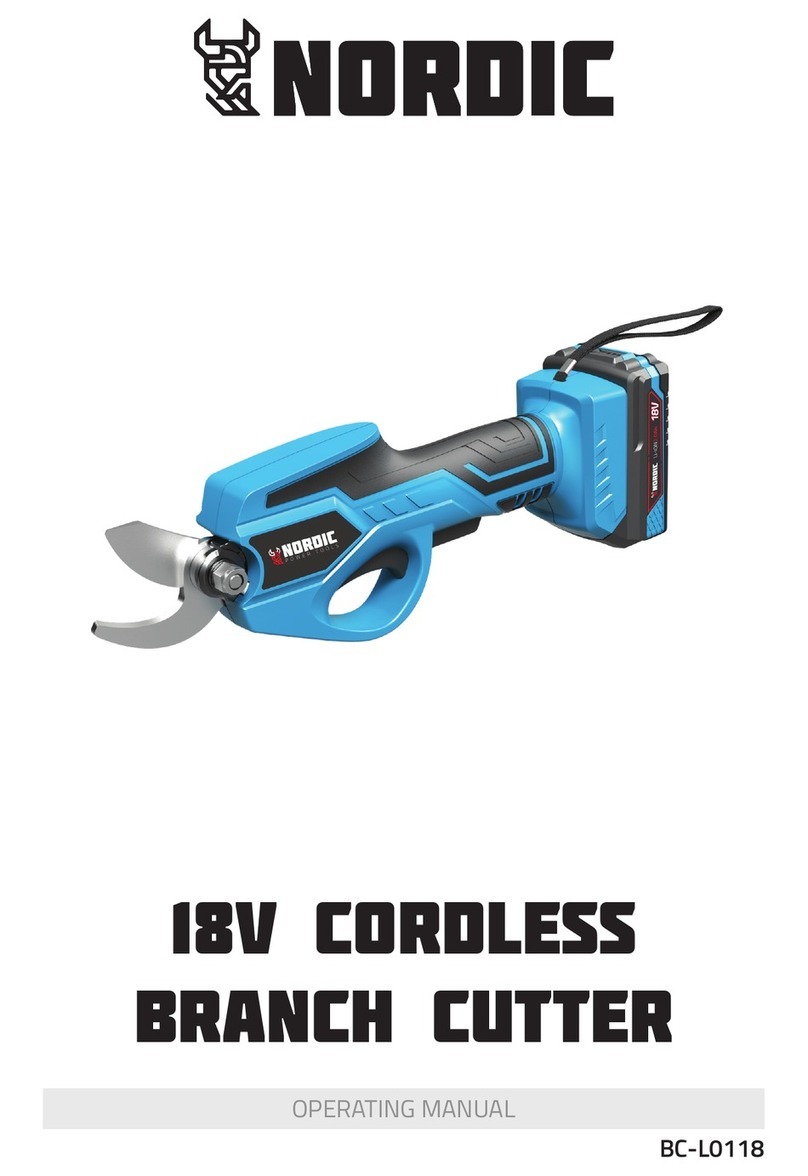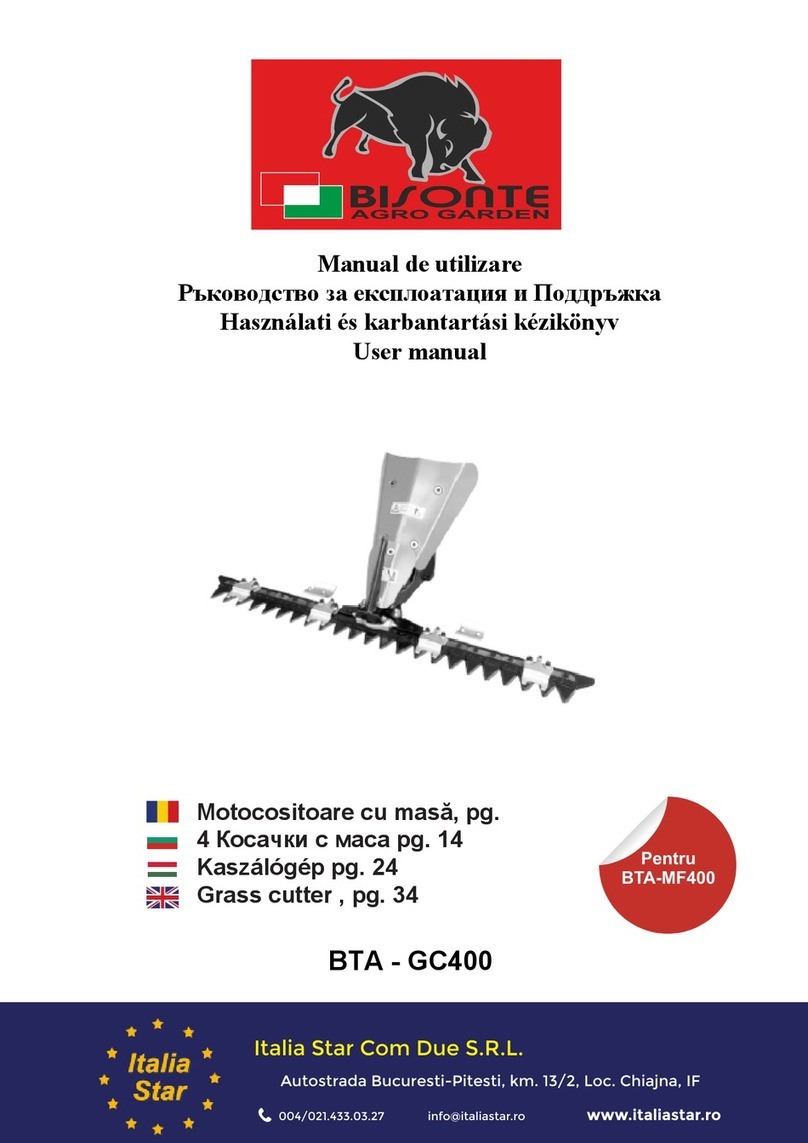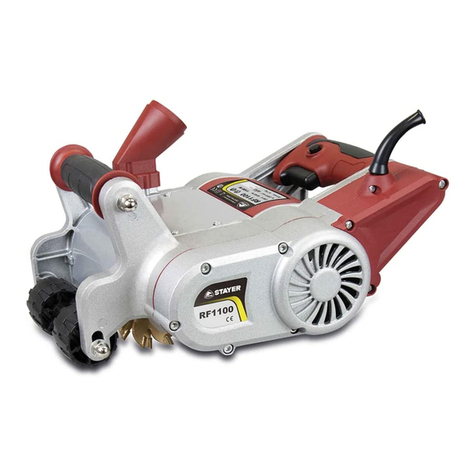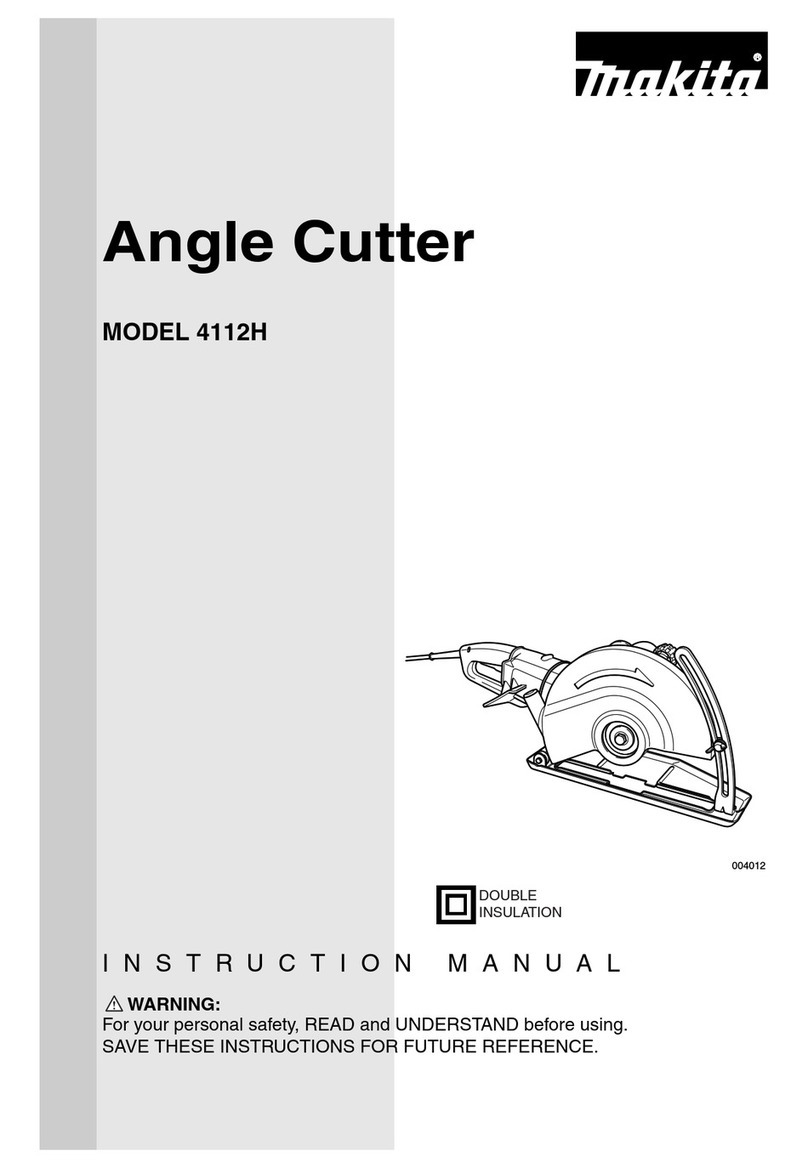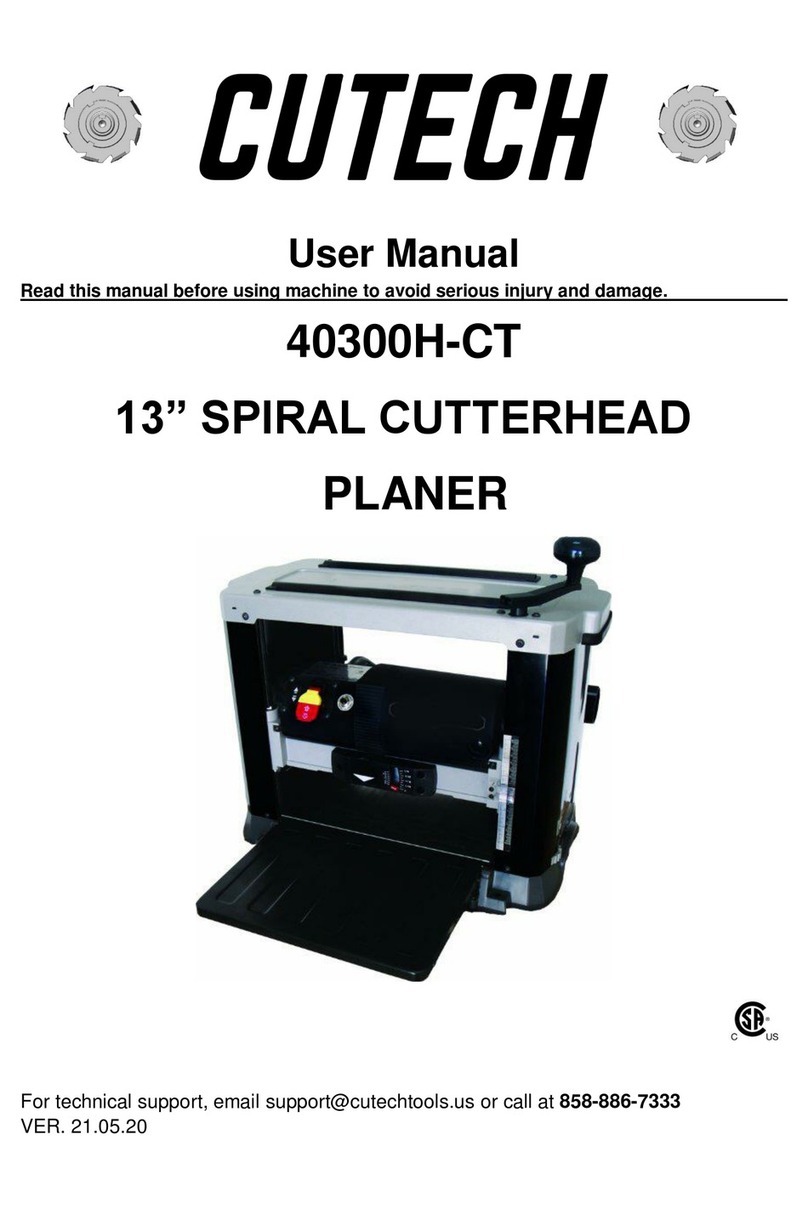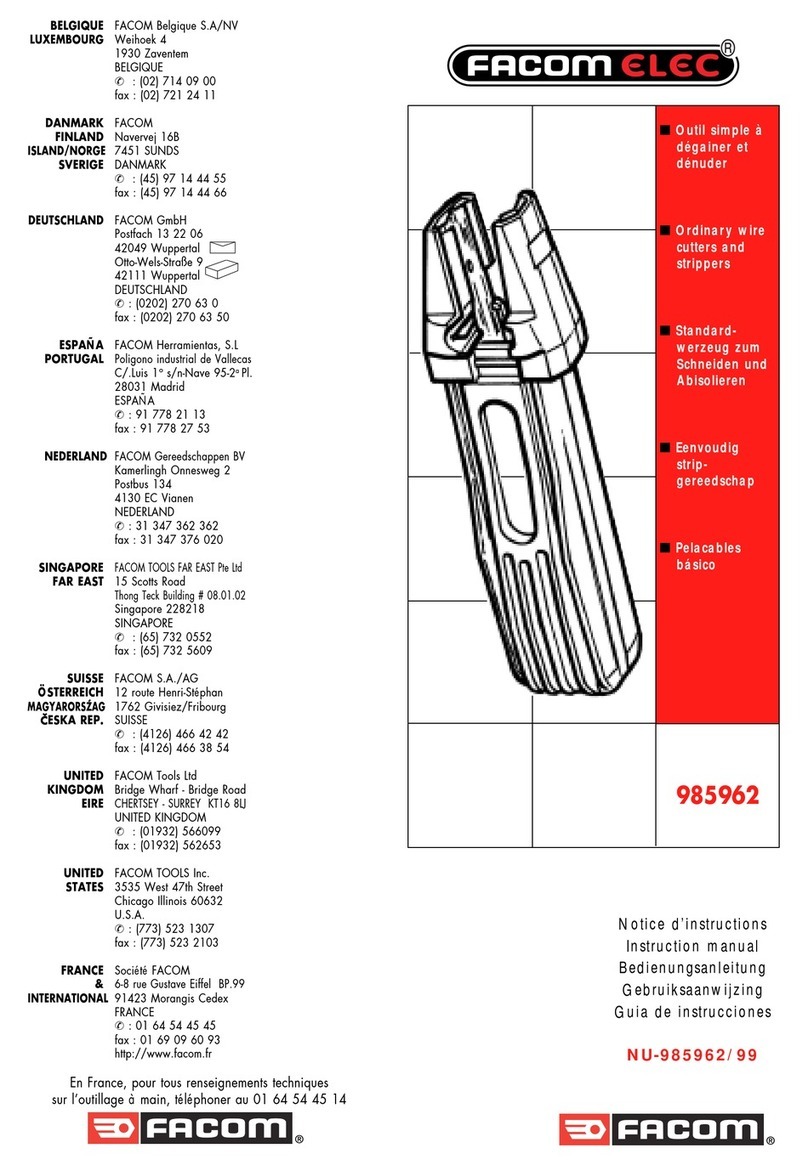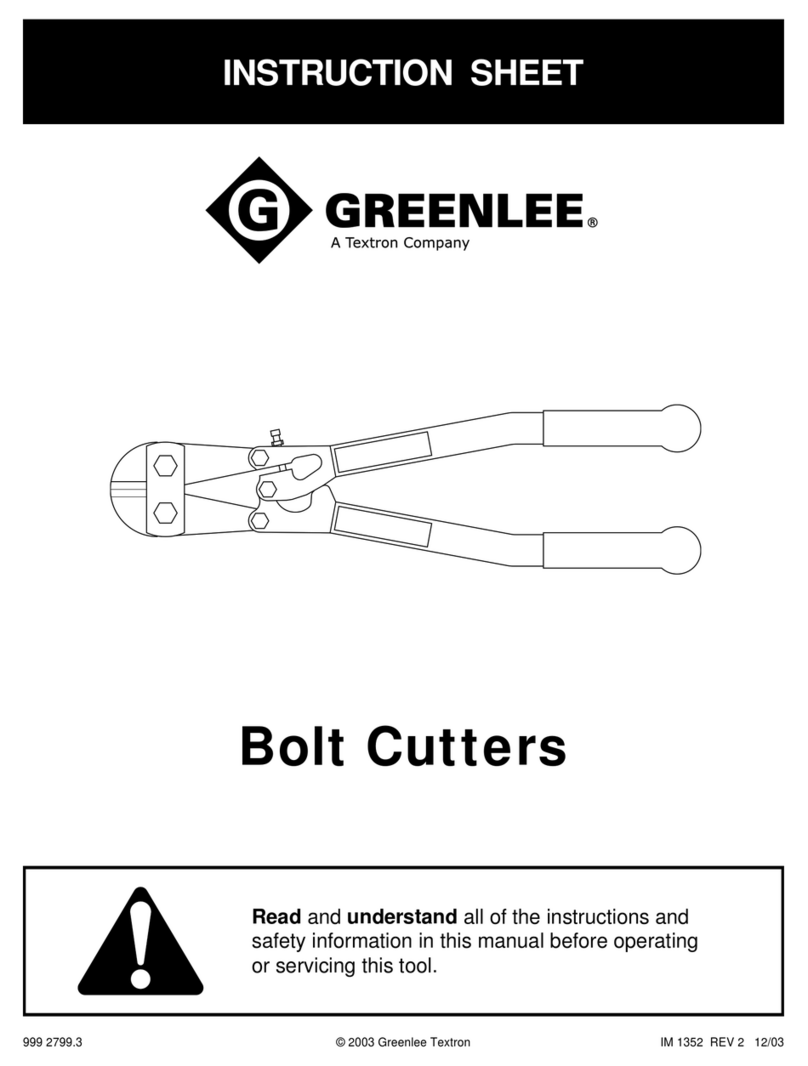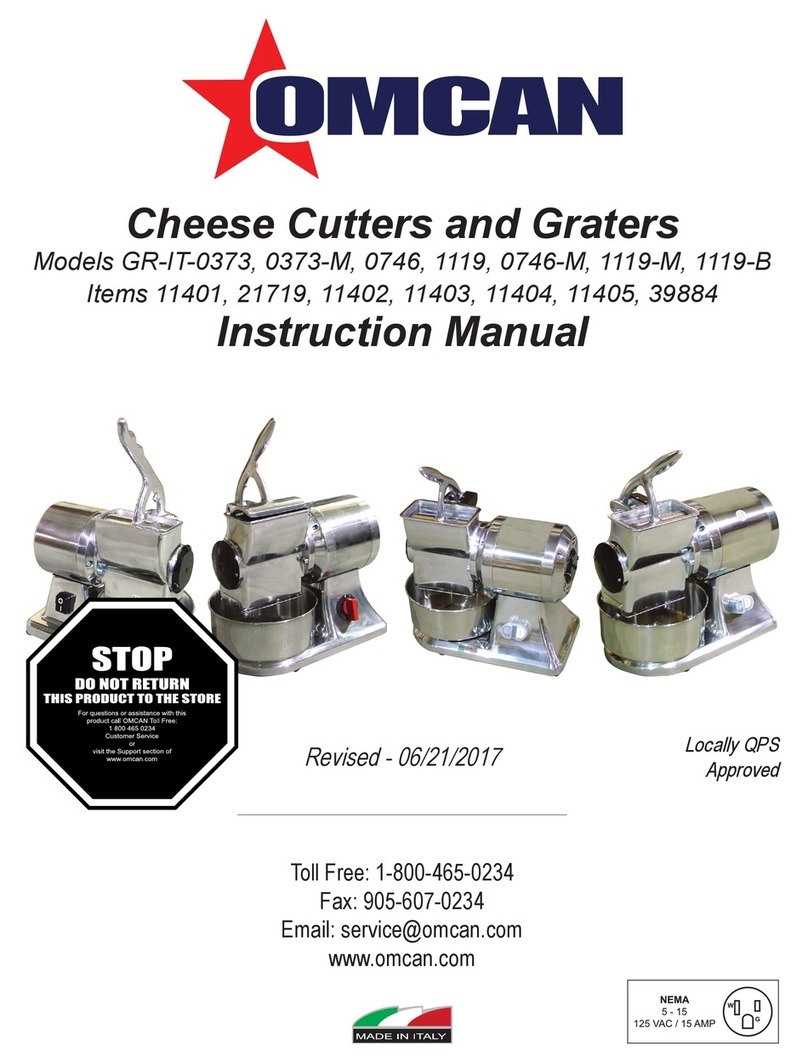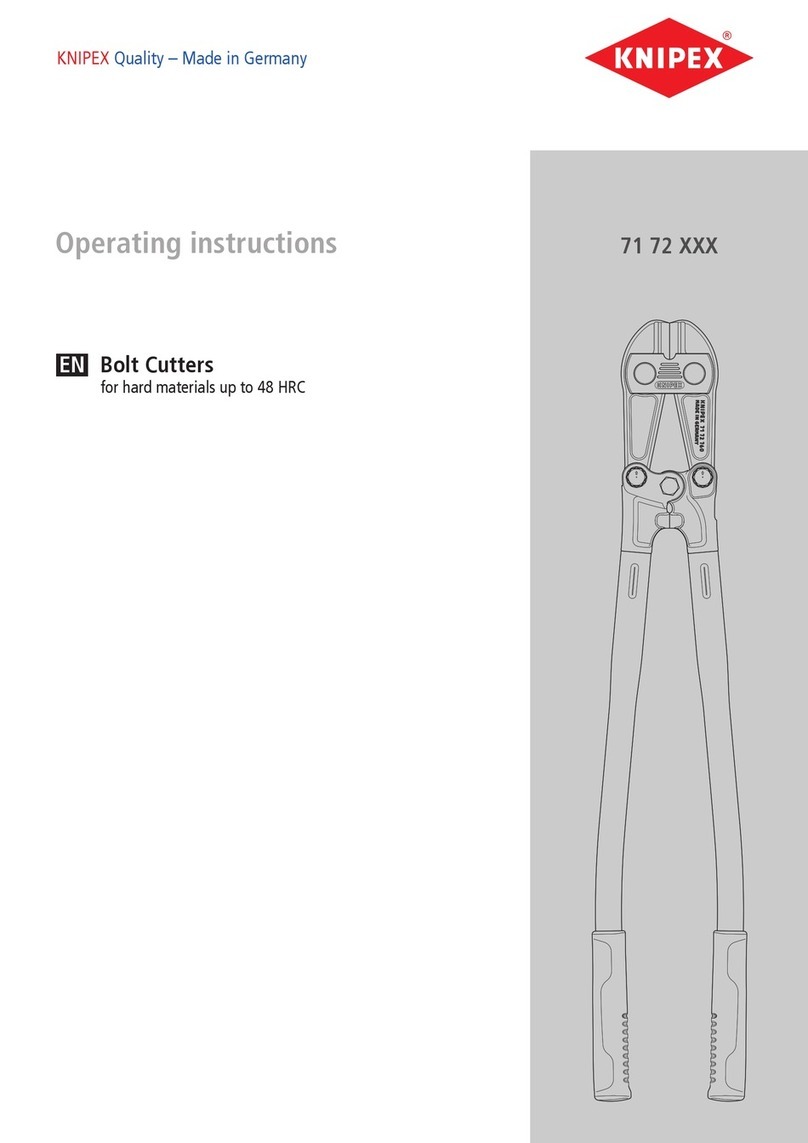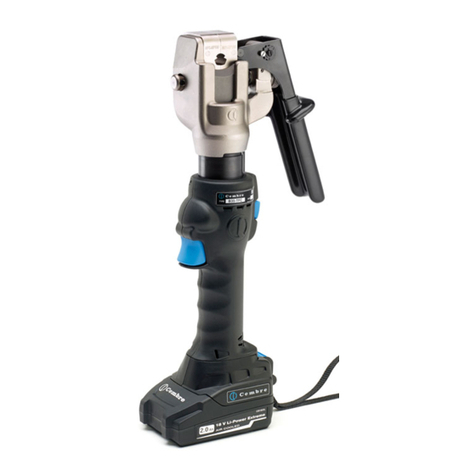Allpax SM4 User manual

Technical Specifications Model SM4
Allen Rotary-Style Gasket Cutter
Operating Instructions
2000A01?????
54 Second Avenue
Chicopee, MA 01020
Phone (413) 594-4400
Toll Free (800) 482-7324
Fax (413) 594-4884
A DIVISION OF
HOLLOW PUNCH TOOLS & HAMMERS
Also available from Allpax Gasket Cutter Systems
lPatented locking system for quick and easy
interchange of cutting heads
l
Unique design cuts holes (single diameter),
or cuts rings (dual diameter) in one operation
lHardened steel
cutting heads
stay sharp
HOLLOW PUNCH TOOLS
Hollow Punch Tool Kit (27 piece kit shown)
DEAD BLOW HAMMERS
lAvailable in Standard (1/8” to 2” OD)
and Metric (2mm to 50mm OD) sizes
l
Convenient 11, 16 and 27 piece kits
HOLLOW PUNCH TOOL KITS
Select the desired diameter cutting head,
snap onto handle, position on top of gasket material,
and strike!
Cut perfect bolt holes,washers & sealing rings.
lHeavy shot-loaded head reduces rebound & absorbs impact
l Soft face eliminates marring; reduces noise
lTapered, textured handle ensures superior grip
lAvailable in 5 sizes; 1 to 3 lbs.

Congratulations! You are the owner of the finest rotary-style gasket cutter in the world. Originally developed and patented in the
1930’s, the heavy-duty Allen SM4 Rotary-Style Gasket Cutter is ideal for the custom fabrication of both metallic and non-metallic
ring and flange gaskets. Thousands are in use everyday in a wide range of industries including petrochemical plants, shipyards,
power plants, breweries, pulp and paper plants, refrigerated facilities, and oil refineries. Easy to operate and virtually
maintenance-free, the SM4 will cut perfect gaskets and provide trouble-free operation for years to come.
INTRODUCTION ASSEMBLY
Carefully unpack the unit. For shipping, the scale bar is stored in an
inverted position. Loosen the scale bar T-screw and remove the scale
bar. Re-insert the scale bar into its proper position and tighten T-screw.
The Model SM4 comes pre-adjusted at the factory.
MOUNTING THE UNIT
(Figure 1) Model SM4 is a heavy-duty unit and is typically bolted
to the flat surface of a workbench using the four 3/8” diameter holes
on the mounting base.
OPERATING THE UNIT
Model SM4 is designed to cut both metallic and non-metallic gasket
materials. It ships with a factory installed top cutting disc designed
for cutting metal gasket materials. A spare top cutting disc designed
for cutting non-metal gasket materials is also included and can be
installed in the field.
NOTE: The pre-installed bottom cutter will cut both
metal and non-metal materials.
Select the sheet gasket material to be cut. Measure the material and
cut into a rough square making sure that the shortest side measures
larger than the outside diameter (OD) of the gasket to be cut. Trim the
corners if necessary.
(Figure 3) Loosen the scale bar T-screw and slide the scale bar to
the desired OD setting. Hand tighten the T-screw.
NOTE: Markings on the scale bar designate radius, not
diameter.
(Figure 4) Disengage the top cutting disc by rotating the cutting
disc lever counter-clockwise.
For metallic gasket materials, punch, or drill, 3/8” guide hole in the
approximate center of the trimmed gasket material. For non-metallic
gasket materials, punch 11/32” guide hole (#13 punch).
NOTE: Punching the exact diameter guide hole ensures
that the gasket material stays centered and that the cutter
tracks properly.
23
(Figure 2) Proper hand crank rotation as viewed from side.
NOTE: In the instructions that follow, turning the hand
crank in the direction of the arrow above is considered
clockwise.
MODEL SM4 SPECIFICATIONS
Weight: 78 pounds
Configuration: Recommended for fixed operation
Mounting: Bench mount
Throat: 8-3/4”
Cutting Diameters: 3”ID to 28”OD with standard scale bar
28”ID to 54”OD with optional scale bar (not included)
54”ID to 80”OD with optional scale bar (not included)
Gasket Width: 1/4” to 8-3/4”
Gasket Thickness (Max): 1/4” (See table for maximum thickness by material)
Recommended Gasket Materials: Metallic or non-metallic
Top Cutting Disc Installed: For metallic gasket materials
Top Cutting Disc Spare: For non-metallic gasket materials
Bottom Cutter Installed: For both metallic and non-metallic gasket materials
MODEL SM4
Maximum Recommended Material Thickness (Inches)
GASKET MATERIAL
Cutter Set
for Non-Metal
Part # M429
Cutter Set
for Metal
Part # M428
Non-Metallic
Asbestos 0.125 N/R
Cardboard (Flat) 0.250 N/R
Cloth Insert 0.250 N/R
Cork 0.250 N/R
Fiber 0.188 N/R
Kevlar 0.010 N/R
Rubber 0.188 N/R
Teflon 0.125 N/R
Metallic
Brass N/R 0.040
Copper N/R 0.063
Iron (Galvanized) N/R 0.040
Lead N/R 0.125
Monel N/R 0.030
Steel (Soft) N/R 0.040
Steel (Stainless) N/R 0.030
Tin N/R 0.040
Zinc N/R 0.040

Congratulations! You are the owner of the finest rotary-style gasket cutter in the world. Originally developed and patented in the
1930’s, the heavy-duty Allen SM4 Rotary-Style Gasket Cutter is ideal for the custom fabrication of both metallic and non-metallic
ring and flange gaskets. Thousands are in use everyday in a wide range of industries including petrochemical plants, shipyards,
power plants, breweries, pulp and paper plants, refrigerated facilities, and oil refineries. Easy to operate and virtually
maintenance-free, the SM4 will cut perfect gaskets and provide trouble-free operation for years to come.
INTRODUCTION ASSEMBLY
Carefully unpack the unit. For shipping, the scale bar is stored in an
inverted position. Loosen the scale bar T-screw and remove the scale
bar. Re-insert the scale bar into its proper position and tighten T-screw.
The Model SM4 comes pre-adjusted at the factory.
MOUNTING THE UNIT
(Figure 1) Model SM4 is a heavy-duty unit and is typically bolted
to the flat surface of a workbench using the four 3/8” diameter holes
on the mounting base.
OPERATING THE UNIT
Model SM4 is designed to cut both metallic and non-metallic gasket
materials. It ships with a factory installed top cutting disc designed
for cutting metal gasket materials. A spare top cutting disc designed
for cutting non-metal gasket materials is also included and can be
installed in the field.
NOTE: The pre-installed bottom cutter will cut both
metal and non-metal materials.
Select the sheet gasket material to be cut. Measure the material and
cut into a rough square making sure that the shortest side measures
larger than the outside diameter (OD) of the gasket to be cut. Trim the
corners if necessary.
(Figure 3) Loosen the scale bar T-screw and slide the scale bar to
the desired OD setting. Hand tighten the T-screw.
NOTE: Markings on the scale bar designate radius, not
diameter.
(Figure 4) Disengage the top cutting disc by rotating the cutting
disc lever counter-clockwise.
For metallic gasket materials, punch, or drill, 3/8” guide hole in the
approximate center of the trimmed gasket material. For non-metallic
gasket materials, punch 11/32” guide hole (#13 punch).
NOTE: Punching the exact diameter guide hole ensures
that the gasket material stays centered and that the cutter
tracks properly.
23
(Figure 2) Proper hand crank rotation as viewed from side.
NOTE: In the instructions that follow, turning the hand
crank in the direction of the arrow above is considered
clockwise.
MODEL SM4 SPECIFICATIONS
Weight: 78 pounds
Configuration: Recommended for fixed operation
Mounting: Bench mount
Throat: 8-3/4”
Cutting Diameters: 3”ID to 28”OD with standard scale bar
28”ID to 54”OD with optional scale bar (not included)
54”ID to 80”OD with optional scale bar (not included)
Gasket Width: 1/4” to 8-3/4”
Gasket Thickness (Max): 1/4” (See table for maximum thickness by material)
Recommended Gasket Materials: Metallic or non-metallic
Top Cutting Disc Installed: For metallic gasket materials
Top Cutting Disc Spare: For non-metallic gasket materials
Bottom Cutter Installed: For both metallic and non-metallic gasket materials
MODEL SM4
Maximum Recommended Material Thickness (Inches)
GASKET MATERIAL
Cutter Set
for Non-Metal
Part # M429
Cutter Set
for Metal
Part # M428
Non-Metallic
Asbestos 0.125 N/R
Cardboard (Flat) 0.250 N/R
Cloth Insert 0.250 N/R
Cork 0.250 N/R
Fiber 0.188 N/R
Kevlar 0.010 N/R
Rubber 0.188 N/R
Teflon 0.125 N/R
Metallic
Brass N/R 0.040
Copper N/R 0.063
Iron (Galvanized) N/R 0.040
Lead N/R 0.125
Monel N/R 0.030
Steel (Soft) N/R 0.040
Steel (Stainless) N/R 0.030
Tin N/R 0.040
Zinc N/R 0.040

OPERATING THE UNIT
(Figure 4) Unscrew and remove the scale bar knurled nut from the
scale bar assembly.
NOTE: The SM4 scale bar knurled nut incorporates a
left-hand thread.
Using the guide hole, position the gasket material onto the threaded
scale bar spindle. Screw the knurled nut back onto the spindle to firmly
secure the material. Hand tighten.
(Figure 6) To cut the OD, engage the top cutting disc by rotating
the cutting disc lever clockwise. The top cutting disc should now pen-
etrate or contact the gasket material and is now in the proper position
for cutting.
(Figure 7) Turn the hand crank clockwise. Simultaneously, with
the other hand, maintain a constant downward pressure on the cutting
disc lever. As the cutting discs rotate, the gasket material will be drawn
towards the cutting discs initiating the cutting process. Continue crank-
ing until the entire OD of the gasket material has been cut. Disengage
the top cutting disc. Discard unwanted material.
(Figure 8) To cut the inner diameter (ID), loosen the scale bar
T-screw, and slide the scale bar to the desired setting. Hand tighten
the scale bar T-screw. Engage the top cutting disc. Turn the hand
crank, simultaneously maintaining downwards pressure on the cutting
disc lever as before. Continue cranking until the entire ID of the gasket
material has been cut. Disengage the top cutting disc and remove the
newly cut gasket. Unscrew and remove knurled nut from spindle.
Discard unwanted material.
(Figure 9) To cut irregular shaped gaskets, mark the shape desired
on the gasket material with a pencil or pen. Loosen the scale bar
T-screw. Remove the scale bar, and manually feed the material through
the cutters while operating the unit in the same manner as above.
An additional set of hands may be needed to guide material.
4 5
NOTE: Cutting thick and/or tough materials may require
more than one revolution through the unit. Flipping the
material over and repeating the above process is often
advantageous.
BOTTOM CUTTER REPLACEMENT
(Figure 10B) Remove gear guard by loosening two hex head cap
screws using 7/16” wrench. Pull off gear guard.
.
(Figure 10A) To replace the bottom cutter, other components of the
unit must be removed first to gain access to the bottom cutter.
(Figure 10D)
(Figure 10E) Slide top shaft assembly out of the frame assembly.
NOTE: For the steps that follow, first disengage the cutting disc lever.
(Figure 10C)
Remove the top shaft assembly by first removing the hex cap screws which hold the top cutter lifter bearing (Figure 10C)
and thrust bearing housing (Figure 10D) in place using 7/16” wrench.

OPERATING THE UNIT
(Figure 4) Unscrew and remove the scale bar knurled nut from the
scale bar assembly.
NOTE: The SM4 scale bar knurled nut incorporates a
left-hand thread.
Using the guide hole, position the gasket material onto the threaded
scale bar spindle. Screw the knurled nut back onto the spindle to firmly
secure the material. Hand tighten.
(Figure 6) To cut the OD, engage the top cutting disc by rotating
the cutting disc lever clockwise. The top cutting disc should now pen-
etrate or contact the gasket material and is now in the proper position
for cutting.
(Figure 7) Turn the hand crank clockwise. Simultaneously, with
the other hand, maintain a constant downward pressure on the cutting
disc lever. As the cutting discs rotate, the gasket material will be drawn
towards the cutting discs initiating the cutting process. Continue crank-
ing until the entire OD of the gasket material has been cut. Disengage
the top cutting disc. Discard unwanted material.
(Figure 8) To cut the inner diameter (ID), loosen the scale bar
T-screw, and slide the scale bar to the desired setting. Hand tighten
the scale bar T-screw. Engage the top cutting disc. Turn the hand
crank, simultaneously maintaining downwards pressure on the cutting
disc lever as before. Continue cranking until the entire ID of the gasket
material has been cut. Disengage the top cutting disc and remove the
newly cut gasket. Unscrew and remove knurled nut from spindle.
Discard unwanted material.
(Figure 9) To cut irregular shaped gaskets, mark the shape desired
on the gasket material with a pencil or pen. Loosen the scale bar
T-screw. Remove the scale bar, and manually feed the material through
the cutters while operating the unit in the same manner as above.
An additional set of hands may be needed to guide material.
4 5
NOTE: Cutting thick and/or tough materials may require
more than one revolution through the unit. Flipping the
material over and repeating the above process is often
advantageous.
BOTTOM CUTTER REPLACEMENT
(Figure 10B) Remove gear guard by loosening two hex head cap
screws using 7/16” wrench. Pull off gear guard.
.
(Figure 10A) To replace the bottom cutter, other components of the
unit must be removed first to gain access to the bottom cutter.
(Figure 10D)
(Figure 10E) Slide top shaft assembly out of the frame assembly.
NOTE: For the steps that follow, first disengage the cutting disc lever.
(Figure 10C)
Remove the top shaft assembly by first removing the hex cap screws which hold the top cutter lifter bearing (Figure 10C)
and thrust bearing housing (Figure 10D) in place using 7/16” wrench.

BOTTOM CUTTER REPLACEMENT (continued from page 5)
(Figure 10E) Remove bottom cutter support bearing by removing two socket head cap screws holding the bottom cutter support bearing in
place. There are two locating pins which align the bottom cutter support bearing to the frame assembly. The pins do not need to be removed, but
you may need a non-marking hammer to help ease the bottom cutter support bearing from the frame assembly as the pins fit tightly.
(Figure 10F) Lift bottom cutter out of frame assembly.
(Figure 10H) Assembly is the reverse of the previous steps.
NOTE: When assembling the top shaft assembly, the
washer assembly for the top cutter lifter bearing must be
assembled with a pin which lines up two washers and the
top cutter disc lifter bearing. Tighten this bolt so that mod-
erate resistance is felt when engaging and disengaging
cutting disc lever.
(Figure 10G)
NOTE: Be aware that a bushing is located inside the hole
holding the bottom cutter. This bushing should be reused
when the bottom cutter is replaced.
TOP CUTTING DISC REPLACEMENT
(Figure 11) Disengage cutting disc lever. Use spanner wrench
(included) and place into corresponding holes in top cutting disc. The
top cutting disc is loosened by holding spanner wrench and turning the
crank handle counter-clockwise. It may be necessary to give the crank
handle a sharp blow with the palm of your hand to initially loosen the
cutting disc. Place new or sharpened cutting disc onto top shaft and
tighten by holding with spanner wrench and turning crank handle
clockwise.
NOTE: Figure 11 shows crank direction for loosening top
cutting disc.
6 7
SHARPENING THE TOP CUTTING DISC FOR NON-METALLIC GASKETS
(Figure 12) Sharpen by holding a small, hand sharpening stone
to bevel side of the cutting disc. Slowly turn the hand crank. Then hold
the stone to the flat face to remove rolled edges or burrs.
NOTE: Sharpening the top cutting disc for metallic gaskets
is not recommended.

BOTTOM CUTTER REPLACEMENT (continued from page 5)
(Figure 10E) Remove bottom cutter support bearing by removing two socket head cap screws holding the bottom cutter support bearing in
place. There are two locating pins which align the bottom cutter support bearing to the frame assembly. The pins do not need to be removed, but
you may need a non-marking hammer to help ease the bottom cutter support bearing from the frame assembly as the pins fit tightly.
(Figure 10F) Lift bottom cutter out of frame assembly.
(Figure 10H) Assembly is the reverse of the previous steps.
NOTE: When assembling the top shaft assembly, the
washer assembly for the top cutter lifter bearing must be
assembled with a pin which lines up two washers and the
top cutter disc lifter bearing. Tighten this bolt so that mod-
erate resistance is felt when engaging and disengaging
cutting disc lever.
(Figure 10G)
NOTE: Be aware that a bushing is located inside the hole
holding the bottom cutter. This bushing should be reused
when the bottom cutter is replaced.
TOP CUTTING DISC REPLACEMENT
(Figure 11) Disengage cutting disc lever. Use spanner wrench
(included) and place into corresponding holes in top cutting disc. The
top cutting disc is loosened by holding spanner wrench and turning the
crank handle counter-clockwise. It may be necessary to give the crank
handle a sharp blow with the palm of your hand to initially loosen the
cutting disc. Place new or sharpened cutting disc onto top shaft and
tighten by holding with spanner wrench and turning crank handle
clockwise.
NOTE: Figure 11 shows crank direction for loosening top
cutting disc.
6 7
SHARPENING THE TOP CUTTING DISC FOR NON-METALLIC GASKETS
(Figure 12) Sharpen by holding a small, hand sharpening stone
to bevel side of the cutting disc. Slowly turn the hand crank. Then hold
the stone to the flat face to remove rolled edges or burrs.
NOTE: Sharpening the top cutting disc for metallic gaskets
is not recommended.

DETAIL BB DETAIL AA
CUTTER ADJUSTMENTS
The positions of the cutting discs are pre-set at the factory. However,
over time, as cutting discs wear and/or are replaced, adjustments may
need to be made to maintain proper operation.
Check the cutting discs to make sure that the cutting edges are sharp,
have no nicks or dings, and are concentric. Replace if necessary.
Ensure that the discs are tight on their respective shafts by tightening
with the spanner wrench. To adjust the cutter refer to the
CUTTER ADJUSTMENT DIAGRAMS on page 9.
Note: Proper cutter adjustment must proceed in the
following order: Top Shaft Assembly End-Play, Clearance,
Depth.
Removing Top Shaft Assembly End-Play
Disengage the top cutting disc (A) by rotating the cutting disc lever
(H) counter-clockwise. Using 1-5/16” wrench, loosen jam nut (C).
Preset thrust bearing (D) to a space of 1/8” with the adjustment pin
(included). Tighten the jam nut against thrust bearing housing (G) with
1-5/16” wrench.
(Figure 13) Remove top shaft assembly end-play by unscrewing
the outer hex-nut (F) with 9/16” wrench and adjusting the inner hex-
nut (E) in, or out. Once end-play is removed (top shaft assembly will
not slide back and forth), lock the inner hex-nut in position. Hold the
inner hex-nut with a wrench and tighten the outer hex-nut snug against
the inner hex-nut, being careful not to change the position of the inner
hex-nut. Double check that end-play has been removed. Crank cutter
handle to make sure the top shaft assembly has not been adjusted too
tight and that it rotates with just slight resistance.
Clearance Adjustment (x axis)
First, set the initial clearance between the bottom cutter (B) and top
cutting disc (A). Loosen the jam-nut until the thrust bearing rotates
freely. Engage the top cutting disc by slowly rotating the cutting disc
lever clock-wise, making sure that the top cutting disc lines up adjacent
to the bottom cutter. Adjust the thrust bearing in or out as necessary to
ensure this alignment using adjustment pin.
Depth Adjustment (y axis)
Note: The correct depth adjustment allows the top cutting
disc to be fully lowered adjacent to the bottom cutter with-
out mechanical interference.
CUTTER ADJUSTMENT DIAGRAMS
8 9
(Figure 15) The depth of cut is adjusted by screwing the depth
adjustment screw (I) in, or out, until 1/32” depth of cut is achieved.
Lock adjustment screw in place with locking nut using 7/16” wrench.
(Figure 14) The correct clearance adjustment for the cutter is
achieved by placing a piece of 0.003” shim stock between the top
cutting disc and the bottom cutter and adjusting until there is slight
resistance on the shim stock.
Note: When making the clearance adjustment, be sure
the outermost edge (diameter) of the top cutting disc does
not interfere with the bottom cutter when engaging cut-
ting disc lever, or damage will occur to the top cutting disc
edge.
DETAIL BB
DETAIL AA
(Figure 16)
NOTES:
1.Wrench size for inner and outer hex nuts – 9/16”
2. Wench size for jam nut – 1-5/16”
3. Wrench size for depth adjustment locking nut – 7/16”
4. Use 0.003 shim stock to adjust clearance (x-axis)

DETAIL BB DETAIL AA
CUTTER ADJUSTMENTS
The positions of the cutting discs are pre-set at the factory. However,
over time, as cutting discs wear and/or are replaced, adjustments may
need to be made to maintain proper operation.
Check the cutting discs to make sure that the cutting edges are sharp,
have no nicks or dings, and are concentric. Replace if necessary.
Ensure that the discs are tight on their respective shafts by tightening
with the spanner wrench. To adjust the cutter refer to the
CUTTER ADJUSTMENT DIAGRAMS on page 9.
Note: Proper cutter adjustment must proceed in the
following order: Top Shaft Assembly End-Play, Clearance,
Depth.
Removing Top Shaft Assembly End-Play
Disengage the top cutting disc (A) by rotating the cutting disc lever
(H) counter-clockwise. Using 1-5/16” wrench, loosen jam nut (C).
Preset thrust bearing (D) to a space of 1/8” with the adjustment pin
(included). Tighten the jam nut against thrust bearing housing (G) with
1-5/16” wrench.
(Figure 13) Remove top shaft assembly end-play by unscrewing
the outer hex-nut (F) with 9/16” wrench and adjusting the inner hex-
nut (E) in, or out. Once end-play is removed (top shaft assembly will
not slide back and forth), lock the inner hex-nut in position. Hold the
inner hex-nut with a wrench and tighten the outer hex-nut snug against
the inner hex-nut, being careful not to change the position of the inner
hex-nut. Double check that end-play has been removed. Crank cutter
handle to make sure the top shaft assembly has not been adjusted too
tight and that it rotates with just slight resistance.
Clearance Adjustment (x axis)
First, set the initial clearance between the bottom cutter (B) and top
cutting disc (A). Loosen the jam-nut until the thrust bearing rotates
freely. Engage the top cutting disc by slowly rotating the cutting disc
lever clock-wise, making sure that the top cutting disc lines up adjacent
to the bottom cutter. Adjust the thrust bearing in or out as necessary to
ensure this alignment using adjustment pin.
Depth Adjustment (y axis)
Note: The correct depth adjustment allows the top cutting
disc to be fully lowered adjacent to the bottom cutter with-
out mechanical interference.
CUTTER ADJUSTMENT DIAGRAMS
8 9
(Figure 15) The depth of cut is adjusted by screwing the depth
adjustment screw (I) in, or out, until 1/32” depth of cut is achieved.
Lock adjustment screw in place with locking nut using 7/16” wrench.
(Figure 14) The correct clearance adjustment for the cutter is
achieved by placing a piece of 0.003” shim stock between the top
cutting disc and the bottom cutter and adjusting until there is slight
resistance on the shim stock.
Note: When making the clearance adjustment, be sure
the outermost edge (diameter) of the top cutting disc does
not interfere with the bottom cutter when engaging cut-
ting disc lever, or damage will occur to the top cutting disc
edge.
DETAIL BB
DETAIL AA
(Figure 16)
NOTES:
1.Wrench size for inner and outer hex nuts – 9/16”
2. Wench size for jam nut – 1-5/16”
3. Wrench size for depth adjustment locking nut – 7/16”
4. Use 0.003 shim stock to adjust clearance (x-axis)

GENERAL MAINTENANCE AND LUBRICATION
(Figure 17) The Model SM4 is pre-lubricated at the factory. Like
any piece of precision machinery, regular cleaning and lubrication of
all gears, and moving parts is recommended. Light machine oil should
periodically be applied to points A, B, C, D, E, F, G, and H.
Replace worn parts as necessary.
A
10 11
Replacement parts are available from your local distributor or
direct from the factory. Contact our Customer Service Department
for pricing information.
ITEM QTY PART NO DESCRIPTION
1 1 M413 STANDARD SCALE BAR (2”-28”)
2 1 M413A MEDIUM SCALE BAR (28”-54”)
3 1 M413B LONG SCALE BAR (54”-80”)
4 1 M420 SCALE BAR KNURLED NUT
5 1 M414 BOTTOM CUTTER (GEARED)
6 1 M415A TOP CUTTING DISC FOR METAL
7 1 M312 TOP CUTTING DISC FOR NON-METAL
REPLACEMENT PARTS
B
C
D
E
F
G
(Figure 18)
TO SEE THE SM4 IN ACTION
SCAN THE QR CODE BELOW
H

GENERAL MAINTENANCE AND LUBRICATION
(Figure 17) The Model SM4 is pre-lubricated at the factory. Like
any piece of precision machinery, regular cleaning and lubrication of
all gears, and moving parts is recommended. Light machine oil should
periodically be applied to points A, B, C, D, E, F, G, and H.
Replace worn parts as necessary.
A
10 11
Replacement parts are available from your local distributor or
direct from the factory. Contact our Customer Service Department
for pricing information.
ITEM QTY PART NO DESCRIPTION
1 1 M413 STANDARD SCALE BAR (2”-28”)
2 1 M413A MEDIUM SCALE BAR (28”-54”)
3 1 M413B LONG SCALE BAR (54”-80”)
4 1 M420 SCALE BAR KNURLED NUT
5 1 M414 BOTTOM CUTTER (GEARED)
6 1 M415A TOP CUTTING DISC FOR METAL
7 1 M312 TOP CUTTING DISC FOR NON-METAL
REPLACEMENT PARTS
B
C
D
E
F
G
(Figure 18)
TO SEE THE SM4 IN ACTION
SCAN THE QR CODE BELOW
H

Technical Specifications Model SM4
Allen Rotary-Style Gasket Cutter
Operating Instructions
HOLLOW PUNCH TOOLS & HAMMERS
Also available from Allpax Gasket Cutter Systems
l Patented locking system for quick and easy
interchange of cutting heads
l
Unique design cuts holes (single diameter),
or cuts rings (dual diameter) in one operation
l Hardened steel
cutting heads
stay sharp
HOLLOW PUNCH TOOLS
Hollow Punch Tool Kit (27 piece kit shown)
DEAD BLOW HAMMERS
l
Available in Standard (1/8” to 2” OD)
and Metric (2mm to 50mm OD) sizes
l
Convenient 11, 16 and 27 piece kits
HOLLOW PUNCH TOOL KITS
Select the desired diameter cutting head,
snap onto handle, position on top of gasket material,
and strike!
Cut perfect bolt holes,washers & sealing rings.
l Heavy shot-loaded head reduces rebound & absorbs impact
l Soft face eliminates marring; reduces noise
l Tapered, textured handle ensures superior grip
l Available in 5 sizes; 1 to 3 lbs.
Table of contents
